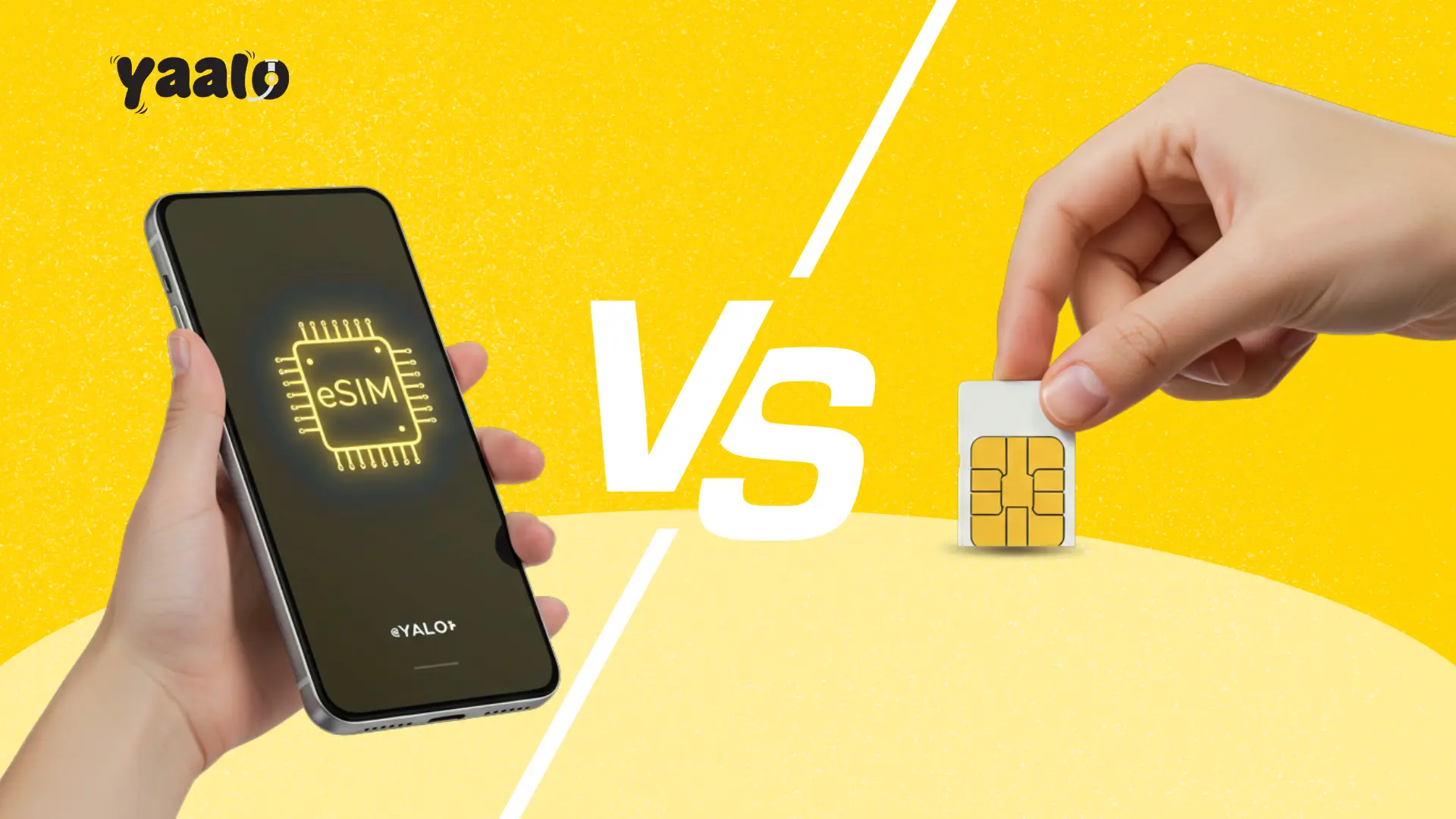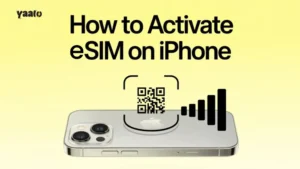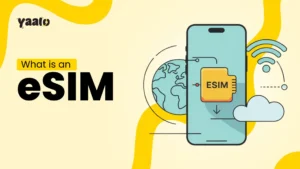eSIM vs physical sim, a common debate about which has the best signal strength. eSIM or embedded SIM is a digital SIM card that is designed to enhance worldwide connectivity. Physical SIM is the physical chip that connects your device to the network and allows you to make calls and send texts. Initially, the physical SIM was a massive innovation that made a wireless connection possible for the first time. Over time, the development in the telecommunication industry introduced us to a new technology known as eSIM. Currently, people are switching their physical SIMS with eSIM cards. Why is it happening, and how are eSIM and physical SIM different from each other?
In this article, I will go through the details about eSIM vs physical SIM. How do these SIMs work, and what are their pros and cons?

What is an eSIM?
eSIM or embedded SIM is a programmable chip integrated into devices. It allows you to save multiple eSIM profiles in your device, and you can remotely switch between these to enhance your data connection. eSIM technology is built into the latest smartphones, laptops, tablets and smartwatches. eSIM provides you flexible and effortless data connection at your destination once activated.
What is a physical SIM card?
A SIM card is the physical chip that is inserted into the device through a SIM slot. Unlike an eSIM, you can remove it from your device. It helps your mobile phone connect with the network and allows you to make calls. It stores users’ information and helps your device identify the network. The first made SIM was full-sized SIM, which evolved to Mini SIM, Micro SIM, Nano SIM, and eSIM.
What is the Difference between eSIM and Physcial SIM?
eSIM is the digital version of the SIM card, and both provide connectivity. But still, both SIMs are different from each other. The key difference between these is given here.
| Features | eSIM | Physical SIM |
| Physical appearance | No physical appearance | Small plastic chip card |
| SIM activation | QR code and manual activation | Manual SIM insertion |
| Device support | Only the latest devices support eSIM | Universally supported by all devices |
| Network shifting | Remote carrier switching | Physical SIM card swapping |
| Security | Enhanced security | SIM can be damaged and stolen |
| Travel benefits | Ideal for frequent travelers | Not beneficial like eSIM |
eSIM vs Physical SIM: Advantages and Disadvantages
Advantages of eSIM
If your device is equipped with an eSIM card, you can get an internet connection more easily compared to a SIM card.
- Remote Activation: An embedded offer for the remote setup, you don’t need to visit the SIM card store. You can confirm each thing from your mobile. QR code and manual activation are used to activate a digital SIM.
- No Roaming Charges: eSIM is the best travel companion that allows travel throughout your destination country without any roaming charges.
- Enhanced Security: Compared to a physical SIM, eSIM is integrated into the device, therefore no chance of stolen or damage.
- Store Multiple Networks: Users can store multiple carrier lines in their device and switch between these to get an improved data connection.
- Offer Flexible data for Travellers: Yaalo eSIM offers convenient data for travellers. If you are travelling to more than one country, eSIM provides you with flexible data across borders.
- Allow to use Physical SIM: You can use a physical SIM number and eSIM on a single device. Set an eSIM to access data, while a physical SIM to make calls and texts.
- Perfect for IoT Devices: eSIM is ideal for use in IoT devices. It enables the devices to connect with the cellular network.
- Cost-Effective: Getting a data connection through eSIM during international travel is cost-effective. It does not add up to your travel budget like local SIM cards and international roaming.
Disadvantages of eSIM
- Limited Device Compatibility: eSIM can’t be used in all devices. It only works in the latest models of smartphones, laptops, tablets, and smartwatches. The smartphone companies that offer eSIM in their latest devices include Samsung, Motorola, Apple, Google Pixel, Huawei, Oppo, and Sony.
- Difficult to Transfer Between Devices: Like a SIM card, an eSIM is not easy to transfer to another device. In case of a SIM card, you just remove your SIM from the old device slot and insert it into the new one. However, eSIM can’t be removed from the device; it is quite complicated to transfer from one device to another.
- Complex Setup: eSIM setup is complex for new eSIM users; you need to navigate through the settings to activate eSIM.
Advantages of Physical SIM
- Easy to Set Up: Unlike an eSIM, a physical SIM card is easy to set up. You just need to insert the SIM into the device through the SIM card slot, and it starts working.
- Wide Device Compatibility: SIM cards have no compatibility limit. All devices universally support it.
- Instant Network Connection: Once you insert the SIM card in the device, it instantly connects with the cellular network without navigating through different settings.
- Manufacturers’ Policies: Like an eSIM, physical SIM cards don’t have manufacturers’ restrictions. Users can switch to different networks without any limitation.
- Quick SIM Transfer: You can easily transfer your physical SIM from one device to another. It is not as complex as transferring an eSIM.
Disadvantages of Physical SIM
- High Security Risk: Physical SIM is a small chip card that has a higher chance of being stolen or damaged during travel. It has a higher risk of hacking and SIM swapping compared to an eSIM card.
- Stick to One Network Only: With a SIM, you can’t use multiple carrier accounts. It offers limited flexibility and is tied to a single network.
- Time Consuming Activation: Traditional SIM offers manual activation. You need to contact the carrier and visit the SIM card store to buy it or to fix the issues.
Which is the best choice for you?
eSIM vs physical SIM: which is best for you? It actually depends on your requirements. If you are a traveler or a business owner, eSIM is the best option for you. It helps to keep your business and personal lines separate. Travelers can use multiple networks to improve their data availability during international travels. You can access convenient cellular data throughout your travel.
A SIM card is good for personal use. You can get a flexible connection to make calls and texts.
Conclusion
If you are confused about whether to choose eSIM or a physical SIM for cellular connection. This article will help you make the decision. I have discussed the details about what eSIM and physical SIM, how these are different from each other, and their pros and cons.
Before choosing between these, confirm your needs and then go for the option that suits your requirements.
FAQs
Is eSIM better than a physical SIM?
Yes, compared to the physical SIM, eSIM provide a more secure and convenient data connection. It allows the users to try multiple networks at a time while a SIM card only sticks to one network.
Does eSIM have numbers?
It depends on eSIM and the plan you are buying. Data-only SIM usually don’t have a number. While the data, voice, and text plan of eSIM include a number to make calls.
- What is eSIM, and How Does it Work? - October 7, 2025
- Is eSIM Safe for Banking? Guide for Secure Mobile Banking! - October 1, 2025
- eSIM Compatible Laptops: Ultimate Guide and List for 2025! - September 30, 2025







